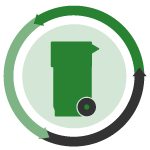 Despite packaging lightweighting, Canada boosted the amount of plastic it collected for recycling in 2014, and Houston installs 10 additional glass-collection bins.
Despite packaging lightweighting, Canada boosted the amount of plastic it collected for recycling in 2014, and Houston installs 10 additional glass-collection bins.

 Despite packaging lightweighting, Canada boosted the amount of plastic it collected for recycling in 2014, and Houston installs 10 additional glass-collection bins.
Despite packaging lightweighting, Canada boosted the amount of plastic it collected for recycling in 2014, and Houston installs 10 additional glass-collection bins.
 A Canadian foam processing company receives a major injection of capital, and San Antonio hopes fines will get people in the mood to recycle.
A Canadian foam processing company receives a major injection of capital, and San Antonio hopes fines will get people in the mood to recycle.
 California’s recycling goal is under scrutiny, and a major Canadian city is getting out of the collection business.
California’s recycling goal is under scrutiny, and a major Canadian city is getting out of the collection business.
 A Vermont materials recovery facility shuts down, and Ikea announces efforts to boost its already high recycling rate.
A Vermont materials recovery facility shuts down, and Ikea announces efforts to boost its already high recycling rate.
 The Windy City’s recycling rate sees another drop, and some residents are unhappy with the way Charlotte, N.C. wants OCC placed in the cart.
The Windy City’s recycling rate sees another drop, and some residents are unhappy with the way Charlotte, N.C. wants OCC placed in the cart.
 A couple of cities consider adding curbside service, and two other municipalities wrestle with the difficulties of providing recycling service to apartment buildings.
A couple of cities consider adding curbside service, and two other municipalities wrestle with the difficulties of providing recycling service to apartment buildings.
 An initiative emphasizes the job creation that recycling can bring, and a San Antonio facility is again ordered to vacate its premises due to alleged violations. Continue Reading
An initiative emphasizes the job creation that recycling can bring, and a San Antonio facility is again ordered to vacate its premises due to alleged violations. Continue Reading
 Some lawmakers say it’s time to update Pennsylvania’s 30-year-old recycling law, and an Indiana elementary school wins the Recycle-Bowl competition.
Some lawmakers say it’s time to update Pennsylvania’s 30-year-old recycling law, and an Indiana elementary school wins the Recycle-Bowl competition.
 Chicago wants to better educate residents of a neighborhood posting a 6 percent diversion rate, and two reports calls on Michigan lawmakers to take steps to boost recycling.
Chicago wants to better educate residents of a neighborhood posting a 6 percent diversion rate, and two reports calls on Michigan lawmakers to take steps to boost recycling.
 Seattle collectors will no longer be allowed to flip the lid on residential garbage cans to look for banned compostables.
Seattle collectors will no longer be allowed to flip the lid on residential garbage cans to look for banned compostables.
